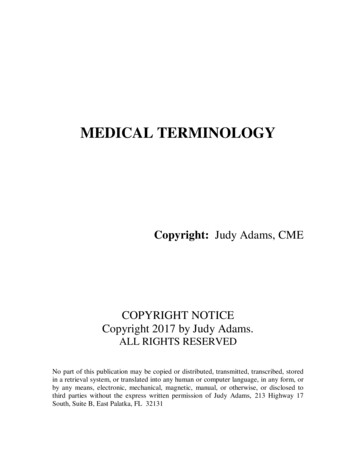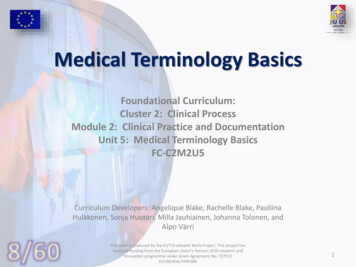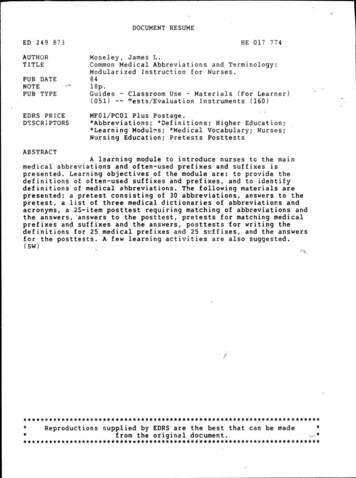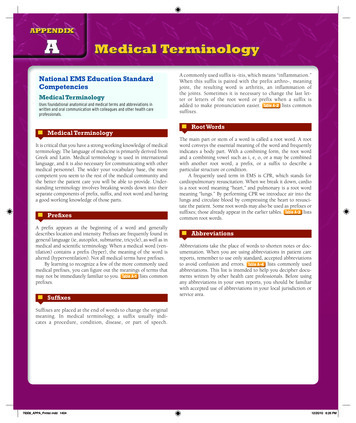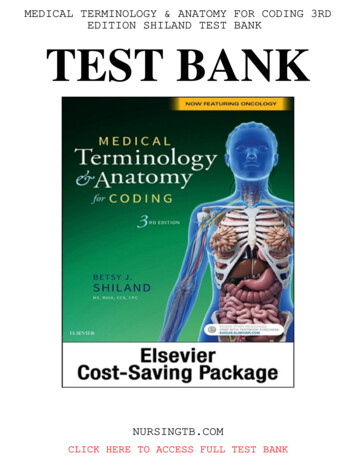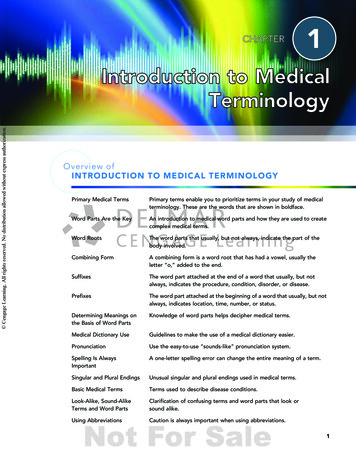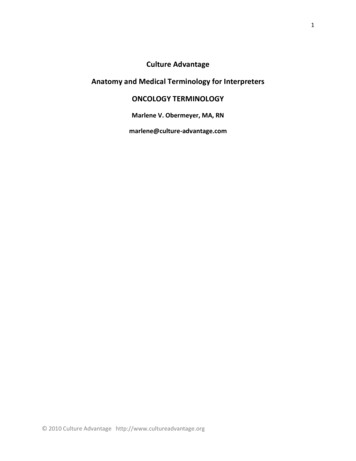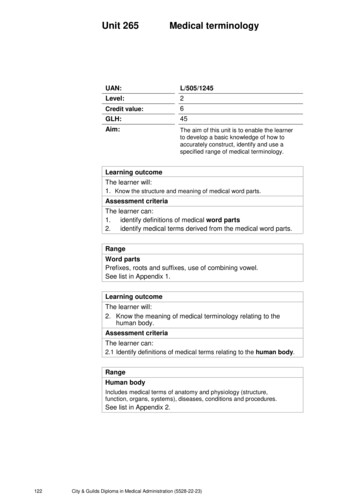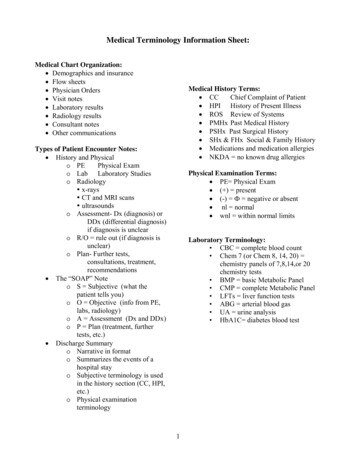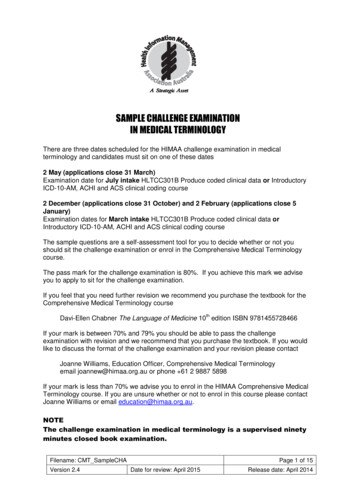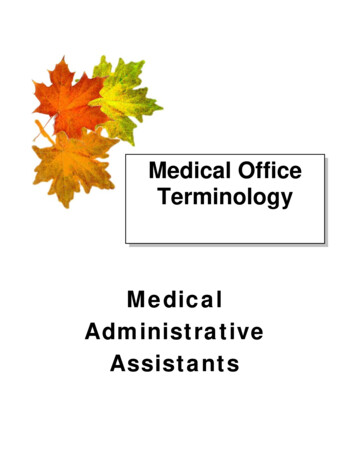
Transcription
Medical OfficeTerminologyMedicalAdministrativeAssistants
AcknowledgmentsWinnipeg Technical College and the Department of Labour and Immigration of Manitobawish to express sincere appreciation to all contributors. Special acknowledgments areextended to the following individuals:Manola Barlow, Independent ContractorRecognition of Prior Learning Coordinator, Winnipeg Technical CollegeDonna Potenza, Medical Administrative Assistant Instructor, Winnipeg TechnicalCollegeFunding for this project has been provided by The Citizenship and Multicultural Division,Manitoba Department of Labour and Immigration.DisclaimerStatements and opinions in this document do not reflect those of Winnipeg TechnicalCollege or the project funder, Citizenship and Multicultural Division, ManitobaDepartment of Labour and Immigration. The information is gathered from a variety ofsources and is current and accurate as of the revision date noted. This information issubject to change and will not be further updated. It is the responsibility of the reader toseek current statistics and information.Please contact the Winnipeg Technical College at 989-6500 or www.wtc.mb.ca if youhave questions about the contents of this document2
Table of ContentsIntroduction ------------------------------------ 4The Health Office Professional ------------ 5Tools: Equipment and Technology ------- 6The Health Office Professional: Crossword ---------------------------------------------- 7Commonly Ordered Tests ------------------ 8Fill in the Blank 1: Acronyms for Commonly Ordered Tests-------------------------- 9Medical Records and Reports ----------- 10Abbreviations/Acronyms ------------------ 11Fill In the Blank 2: Abbreviations/Acronyms -------------------------------------------- 14Preparation of a History and Physical - 15Full Block Format Report Style - 15Modified Block Format Report -- 17Indented Format Report Style -- 19Run-On Format Report --------- 20Short-Stay Record ----------------- 21Interval ----------------------------- 22Miscellaneous Medical Reports -------------------------------------------------- 23Multiple-Choice-Test ----------------------- 30Answer -------------------------------------- 32References ----------------------------------- 333
IntroductionTo become a skilled medical administrator (medical office assistant), you first need tolearn the vocabulary (language) of the medical administration profession. The sectionsin this booklet introduce you to some of the basic terms you will need. Once youunderstand the language of medical office assistants, you will be prepared to interpretand communicate information accurately.This guide mainly focuses on some of the essential terms in the medical administrationprofession. Self-tests and answer keys have been included in this guide. The activitiesare designed to be completed after you have studied the corresponding unit. After youhave read and understood the material you can try the tests yourself. If you score below80% on the self-tests, it is recommended that you go back and review those areas.If you would like to study more in depth, there is a list of references at the back of thispackage.4
The Health Office ProfessionalAllied health care - Any duty or profession that supports primary health-careprofessionals, such as physicians, in delivering health-care services.Client - A person seeking or receiving health care; synonymous with patient, butsuggests a more active role.Clinic - A facility providing medical care on an outpatient basis. Many clinics have aspecialty such as ongoing care for diabetes or cancer.Core competency - The basic or essential skills that one needs to succeed in aparticular profession. (For example, a health office professional needs computer skills.)Externship - A co-operative or workplace experience or period of training for a studentthat is provided by the student’s educational facility.Internship - A period of time spent doing a job as part of becoming qualified to do it.For example, “Jane has a summer internship at a local hospital.”Licensure - A legal document, obtained after passing written and clinical examinationsthat is required for health-care practitioners in regulated fields.Medical Assistant - A person who is trained to assist a physician with various clinicaltests, examinations and procedures.Medical Office Assistant - A person who primarily handles administrative but alsosome clinical duties in a health office.Regulated Profession - A profession that is legally restricted to practitioners with aspecific professional qualification and/or provincial registration.5
Tools: Equipment and TechnologyDue to the diversity of roles for Medical Administrative Assistants (hospital admitting,Winnipeg Regional Health Authority and doctors’ offices), various machines andcomputer programs are used. These include Transcription, Microsoft Office,GroupWise, Max Gold or other scheduling software, computers with admitting, transferand discharge (ADT) functions.6
The Health Office Professional: CrosswordAcrossDown3. A person receiving health care1. A facility providing medical care4. A co-operative or workplace experience2. Obtained after passing written andclinical examinations3. Essential skills7
Commonly Ordered Tests11Thompson, D.V. (2005). Administrative and Clinical Procedures for the Health Office Professional.(p.141) Toronto, Ontario: Pearson Prentice Hall.8
Fill in the Blank 1: Acronyms for Commonly OrderedTestsDirections: Read page 8. Study the acronyms that are used for commonly ordered tests.Write down what the acronyms stand for in the blanks. (Try to fill this in without lookingback at page 8.)Example: C&S Culture and /EKG:7.)HBV:8.)MRI:9.)RBC:10.)Pap:9
Medical Records and ReportsMedical Chart Notes and Progress NotesWhen a patient comes into the office or specialty clinic for the first visit, a chart isprepared. There are different kinds of charts that are used, as you will see in thisbooklet. It is important to be neat, accurate, complete and timely when recording charts.This should be done as soon as possible after the patient is seen.A social data sheet is a form with the patients’ personal information, such as theirmedical health number, address, date of birth, other insurance information, etc.Chart notes (also called progress notes) are the formal or informal notes taken by thephysician when he or she meets with or examines a patient in the office, clinic orhospital.2Complete Documentation1.)The patient records must be complete and easy to read.2.)Each meeting with a patient should include: Date Reason for the visit History, physical examination, prior diagnostic test results Diagnosis (assessment, impression) Plan for care Name of the observer3.)Reason for ordering diagnostic or other services should be written down.4.)Health risk factors e.g., smoking, heart condition, diabetes, etc., should beidentified.5.)Progress, response to treatment, changes in treatment and revision of diagnosisshould be written down. 32Diehl, M.O. (2002). Medical Transcription: Techniques and Procedures. 5th Edition. (p .262). St. Louis,Missouri: Saunders.10
Patient’s HistoryThe history includes the chief complaint (CC), the history of the present illness (HPI),the review of systems (ROS), and past history, family and/or social history (PFSH).The chief complaint (CC) describes the symptom, problem or condition that is thereason for the encounter and must be clearly described in the record.The history of the present illness (HPI) is the description of the development of thepatient’s present illness from the first sign and/or symptom or from the previousencounter to the present.A review of symptoms (ROS) inquires about the system directly related to theproblems identified in the HPI.Abbreviations/AcronymsMany facilities now are trying to encourage doctors to discontinue the use ofabbreviations and slang, but that will take some time. Below are 20 commonabbreviations. (Specific abbreviations may be different in different clinics and hospitals.)abd for abdomenafib for atrial fibrillationconsult for consultationC-section for caesarian sectiondiff for differential(lab)dig for digitalis (heart drug)3Diehl, M.O. (2002). Medical Transcription: Techniques and Procedures. 5th Edition. (p. 263) St. Louis,Missouri: Saunders.11
Dob Date of BirthDX Diagnosis, impression (IMP)echo for echocardiogramH&H for hemoglobin and Hematocrit (lab)hep lock for heparin locklab for laboratoryLytes for electrolytes (lab)pap test for papanicolaou testpath for pathologyPE (or PX) Physical examinationpost-op for postoperative (after the operation)pre-op for preoperative (before the operation)prepped for to prepareRX PrescriptionRx for prescriptiontach for ventricular tachycardiatachy for rapid or fastvitals or VS for vital signs (Temp, BP)12
Abbreviations Used in Scheduling13
Fill In the Blank 2: Abbreviations/AcronymsDirections: After you study the acronyms on page 11, complete the questions NP:7.)BP:8.)Can:9.)PE:10.)Inj:14
Preparation of a History and Physical:Full Block Format Report Style4de Mars, Verna Marie 76-83-06Cortland M. Struthers, MDHISTORYCHIEF COMPLAINT:Prolapse and bleeding after each bowel movement for the past 3-4 months.PRESENT ILLNESS:This 68-year-old white female says she usually has three bowel movements a day in small amounts, and there has been arecent change in the frequency, size and type of bowel movement she has been having. She is also having some pain andirritation in this area. She has had no previous anorectal surgery or rectal infection. She denies any blood in the stool itself.PAST HISTORY:ILLNESSES: The patient had polio at age 8 from which she has made a remarkable recovery. Apparently, she wasparalysed in both lower extremities and now has adequate use of these. She has no other serious illnesses.ALLERGIES: ALLERGIC TO PENICILLIN. She denies any other drug or food allergies. MEDICATIONS: None.OPERATIONS: Herniorrhaphy, 25 years ago.SOCIAL: She does not smoke or drink. She lives with her husband who is an invalid and for whom she cares. She is aretired former municipal court judge.FAMILY HISTORY:One brother died of cancer of the throat; another has cancer of the kidney.REVIEW OF SYSTEMS:SKIN: No rashes or jaundice.HEENT: Unremarkable.CR: No history of chest pain, shortness of breath, or pedal edema. She has had some mild hypertension in the past but isnot under any medical supervision nor is she taking any medication for this.4Ibid, 29115
GI: Weight is stable. See Present Illness.OB-GYN: Gravida 11 Para 11. Climacteric at age 46, no sequelae. EXTREMITIES: No edema.NEUROLOGIC: Unremarkable.j rtD:5-17-0XT: 5-20-0XFull Block Format: Category ExplanationsStatistical Data: This is decided by the medical facility. In some cases, the entirestatistical heading is printed for the medical transcriptionist to include the patient’sname, identification number, physician, date, etc.Title: History or Personal History centered on the page. Typed in all capital letters.Main Topics: Typed in all capitals, followed by a colon and underlined, on a line by itself.Begun on edge of left border.Subtopics: Capitalized, followed by a colon.Data: Begun on the same line as subtopic. Single-spaced. All lines return to the leftmargin. Double-spaced between the last line of one heading and the next heading.Margins: Narrow (1/2” to ¾” is okay.)Close: Typed line for signature. Dictator’s typed name. Transcriptionist’s initials. Date ofdictation (D). Date of transcription (T).55Ibid, 290.16
Modified Block Format Report66Ibid, 293.17
Modified Block Format Report: Category ExplanationsStatistical Data: This is decided by the medical facility.Title: History or Personal History centered on the page. Typed in all capital letters.Main Topics: Typed in all capitals, followed by a colon and underlined; on a line by itself.Begun on edge of left border.Subtopics: Indented on tab stop under main topics. Typed in full capitals, followed by acolon.Data: Begun on the same line as the topic or subtopic. Data input begun two tab stopsafter the heading. Single-spaced. Double-spaced between the last line of one headingand the next heading.Margins: Narrow (1/2” to ¾” is ok.)Close: Typed line for signature. Dictator’s typed name. Transcriptionist’s initials. Date ofdictation (D). Date of transcription (T).7What is the major difference between Full Block Report Format and ModifiedBlock Format Report? (See Answers on page 32)7Ibid, 290.18
Indented Format Report Style8This style is popular because it is clean and easy to read8Ibid, 295.19
Run-On Format Report Style9Run-on format uses much less space on the paper and takes less time to prepare. Thisformat is the most popular one used by the institutions. The history is not typedseparately but continues on into the physical. It closely resembles a chart note.9Ibid, 29620
Short-Stay RecordWhen a patient is being sent to an outpatient or surgical or diagnostic centre, ashortened form of the History and Physical (H&P) is ok
Run-On Format Report Style----- 20 Short-Stay Record----- 21 Interval History----- 22 . not under any medical supervision nor is she taking any medication for this. 4 Ibid, 291 . 16 GI: Weight is stable. See Present Illness. OB-GYN: Gravida 11 Para 11. Climacteric at age 46, no sequelae. EXTREMITIES: No edema. NEUROLOGIC: Unremarkable. j rt D:5-17-0X T: 5-20-0X Full Block Format: Category .
